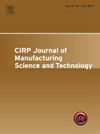Life Cycle Assessment of a steel component produced from electric arc furnace
IF 5.4
2区 工程技术
Q2 ENGINEERING, MANUFACTURING
CIRP Journal of Manufacturing Science and Technology
Pub Date : 2025-03-27
DOI:10.1016/j.cirpj.2025.03.007
引用次数: 0
Abstract
This study aims to assess the environmental impact of manufacturing ready-to-use low-alloy steel pup joints used in drilling in the oil and gas sector. The company uses low alloy steel (AISI 4145H) produced from recycled scrap via the electric arc furnace (EAF) route. The Life Cycle Assessment (LCA) is used for the environmental analysis. Foreground data at plant sites are collected from the CNC machining company in Norway and the production of steel in central Europe. Background data, such as the transportation and electricity origin, are taken from Ecoinvent 3.8. database and from literature. The system boundary of the project is gate-to-gate (from scrap to the pup joint production) and included unit processes are EAF steel production, hot rolling, quenching and tempering, CNC drilling and CNC turning. LCA results show a high contribution to the environmental impacts due to non-renewable electricity sources and materials transport among different companies in central Europe, with the final destination in Norway. Changing the source of electricity for the entire production line would generate environmental benefits. The Global Warming Potential calculated for the scenario of producing the pup joint entirely in Norway, where the electricity grid is based on hydropower (>90 %), was 215CO2eq versus 466 CO2eq for the current production line, mostly conducted in Europe with fossil fuel as main energy source. An ideal scenario can be suggested, namely the creation of an industrial park in Norway, in order to remove the transport and use renewable energy. But, more realistically, the potential limitations of the proposed solution (e.g., infrastructure costs, production capacity in Norway) should be discussed to provide a balanced view of its feasibility.
电弧炉生产钢构件的生命周期评价
本研究旨在评估石油和天然气行业钻井中使用的即用型低合金钢小管接头对环境的影响。该公司使用低合金钢(AISI 4145H),由回收废料通过电弧炉(EAF)路线生产。使用生命周期评价(LCA)进行环境分析。工厂现场的前景数据是从挪威的CNC加工公司和中欧的钢铁生产中收集的。背景数据,如交通和电力来源,取自Ecoinvent 3.8。数据库和文献。项目的系统边界为门到门(从废钢到小接头生产),单元工艺包括电炉钢生产、热轧、淬火回火、数控钻削和数控车削。LCA结果显示,中欧不同公司之间的不可再生电力来源和材料运输对环境影响的贡献很大,最终目的地在挪威。改变整个生产线的电力来源将产生环境效益。完全在挪威生产pup接头的情景计算出的全球变暖潜势为215co2当量,而目前生产线的全球变暖潜势为466 co2当量,主要在欧洲以化石燃料为主要能源。挪威的电网以水力发电为基础(占90%)。可以提出一个理想的方案,即在挪威建立一个工业园区,以消除运输和使用可再生能源。但是,更现实的是,应该讨论拟议解决方案的潜在局限性(例如,基础设施成本、挪威的生产能力),以对其可行性提供一个平衡的看法。
本文章由计算机程序翻译,如有差异,请以英文原文为准。
求助全文
约1分钟内获得全文
求助全文
来源期刊

CIRP Journal of Manufacturing Science and Technology
Engineering-Industrial and Manufacturing Engineering
CiteScore
9.10
自引率
6.20%
发文量
166
审稿时长
63 days
期刊介绍:
The CIRP Journal of Manufacturing Science and Technology (CIRP-JMST) publishes fundamental papers on manufacturing processes, production equipment and automation, product design, manufacturing systems and production organisations up to the level of the production networks, including all the related technical, human and economic factors. Preference is given to contributions describing research results whose feasibility has been demonstrated either in a laboratory or in the industrial praxis. Case studies and review papers on specific issues in manufacturing science and technology are equally encouraged.
 求助内容:
求助内容: 应助结果提醒方式:
应助结果提醒方式:


